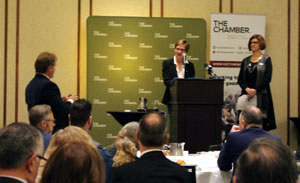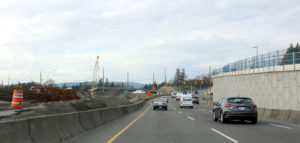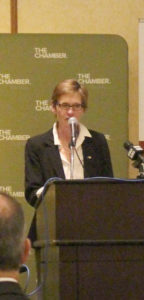
Thursday, January 31, 2019 ~ GREATER VICTORIA / WEST SHORE.
by Mary P Brooke ~ West Shore Voice News
During a speech by BC Minister of Transportation & Infrastructure (MOTI) Claire Trevena at a Victoria Chamber of Commerce luncheon on January 30, about 150 business people and elected officials heard that the South Island Transportation Strategy (SITS) — which is already in the works — will be unveiled by September 2019. And with that will come some funding.
That specific point on funding was asked from the floor by Langford Mayor Stew Young, and Trevena confirmed that dollar amounts will be attached to the new strategy. That could be specific aspects or projects within the strategy, or an overall fund — clarification of that was not given, but a funding formula of some kind will be developed.
“For too long the island’s been neglected,” Trevena said, promising to change that. She herself is of course an islander as the long-time MLA for North Island (including as Transportation critic in Opposition under the BC Liberals 2005-2017) and now Minister of Transportation & Infrastructure under the NDP government since 2017.
Langford’s Mayor is glad about the timeline being within this 2019 calendar year. “The next two months of engagement between the Minister and the municipalities is promising,” said Stew Young. “I’m looking forward to the report in September,” he told West Shore Voice News. As a practical mayor of a municipality that acts quickly to get things done, Young is is particularly pleased that “funding will be attached” to the south island transportation strategy.

She talked about the “huge amount of growth and business development and a very busy real estate market” on south Vancouver Island. In particular because of the desirable year-round moderate climate here, the south island is “where people want to live, come and do business”. Adding, “this does drive the growth.”
“We want to include cities as well as the region in the decision making process of is projects that will impact the area, different communities and the whole province,” said Minister Trevena.

“People are extremely frustrated with congestion. It’s something we do need to work on. To business leaders: your employees are wasting too much time sitting in traffic. We are mapping out a future where future investments could make significant in the lives of commuters and Make Victoria an even more attractive place to do business.” She said the South Island Transportation Strategy is taking a comprehensive approach on “how to get people to and from work and school faster, spend less time in traffic, and more time on quality of life and whatever we do in our spare time”.
“Through the strategy we are tackling congestion issues that have plagued the region for years but have been mostly ignored. We’re not reinventing the wheel here, but building on the work and studies that have already been done. We want to have a strategy which will come up with realistic solutions that incorporate an array of transportation modes we think that will improve traffic flow within the region,” said Trevena.
Potential emergency routes for Malahat in the event of another road closure are part of the analysis for the strategy. “There were four closures last year — four times too many,” the transportation minister said. For the exponential growth in traffic on that corridor, she said “there needs to be a release valve in the event of closure”. MOTI will continue to work with stakeholders and regional options are being explored.” In a few months I will report back on the options. “We want to make sure that first nations, local and environmental interests are well understood.” The resulting strategy will need to be “feasible and meet environmental conditions” and from there will be the engineering work and that will be able to start early this summer.

The strategy will “encourage people to get out of their cars and use other modes of transportation”. What does this looks like? In addition to bus transit, cycling and walking, Trevena mentioned specifics like bike racks on buses and areas for use by skateboarders.
She was pleased with a recent set of roundtable discussions about the E&N corridor that were held with elected reps, indigenous communities, and the Island Corridor Foundation. “It was a progressive step forward,” Trevena said. “The E&N weaves its way through seven municipalities, first nations and regions. “We’re ready to invest and move along with lasting investment along the corridor.” She says she is confident that the government will find common ground among first nations and local municipalities and a good solution for the communities to evolve.

The coastal ferries are an important part of island living. “People deserve to travel affordability and easily on their ferries”, said Minister Trevena. “More people using ferries each year, for work, pleasure, and necessity.” She wants to ensure that “improvements for the present coastal ferry system work for the people it serves”. BC Ferries froze fares between Vancouver Island the Mainland, and lower the fares by 15% on minor routes. Free ferry travel for seniors Monday to Thursday was reinstated — on that point the Minister received some genuine applause.
“Our government is committed to making life more affordable while building a strong and sustainable economy. Transportation is central to that succeeding. Networks need to be safer, more efficient and easier to access,” said Trevena. She said the NDP government will fix bottlenecks for cars, help buses travel easier, allow ways for emergency vehicles to get through the highways without congestion, and support people to choose alternative methods of transport.
Trevena is familiar with the South Island Prosperity Project (SIPP) group that is working on a smart cities proposal which is focused on transportation mobility. Trevena said that government will engage with groups like SIPPS. “We’ll take what’s there and work out a plan that works for communities… working with organizations and getting some of those strategies together. Not dictating, but looking at what the priorities are.”
Other articles:
BC Government announces South Island Transportation Strategy (January 9)
BC Greens support the South Island Transportation Strategy (January 9)


